8 Link Building Metrics to Know for Your Campaigns
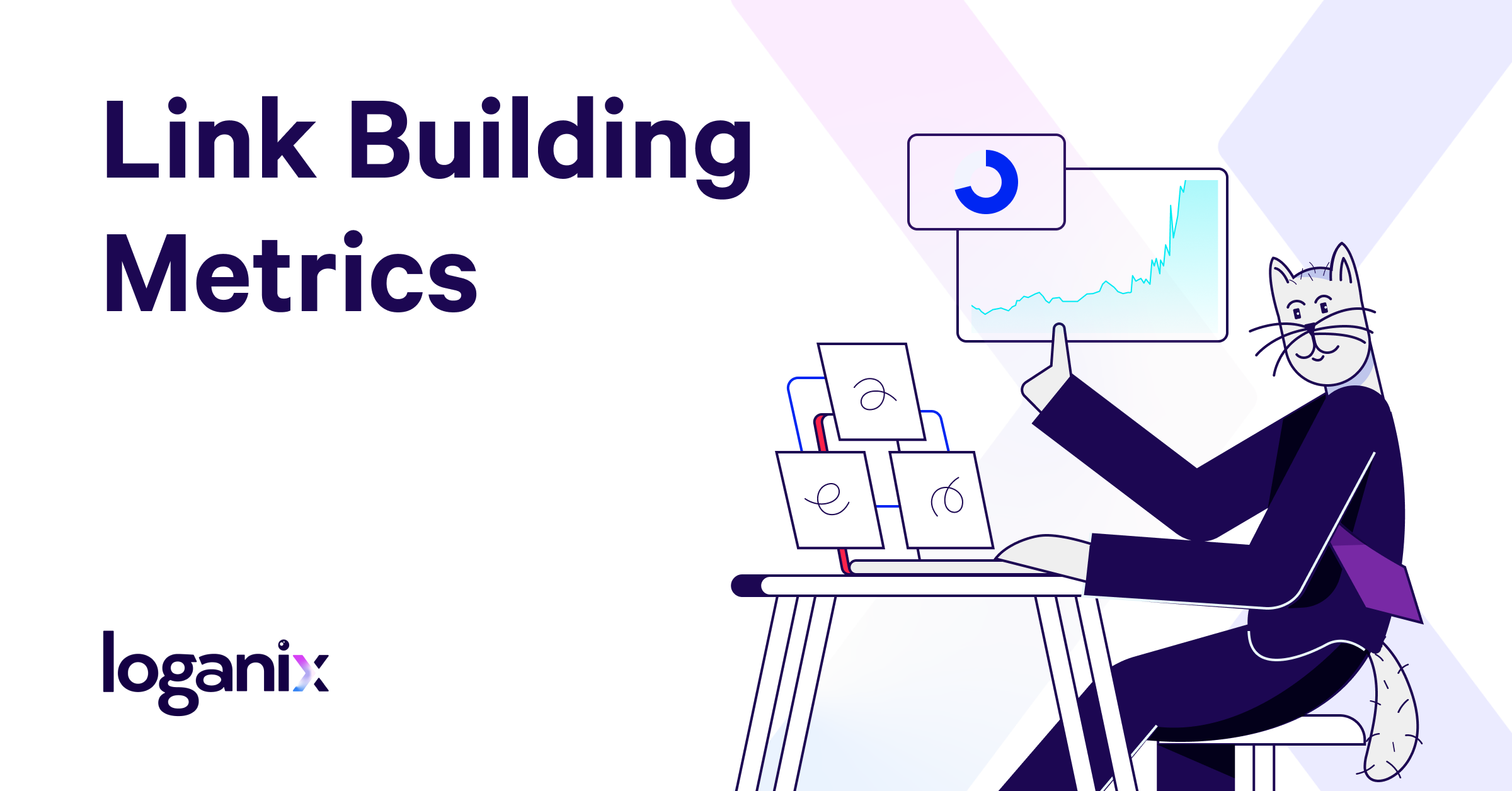
Hand off the toughest tasks in SEO, PPC, and content without compromising quality
Explore ServicesLink building has been one of the pillars for SEO strategies going back to the very beginning. However, a lot has changed since then. You need more effective best practices to measure success.
There are various link research tools for SEO and link building metrics you can find that will give you a good picture of your website’s backlink profile. You can use them to analyze the success of your campaign by tracking the changes and improvements over time.
Knowing what they are, how they work, and how to use them is essential for any SEO starting a link building campaign. You can use our guide to the eight link building metrics you should know to get started.
8 Link Metrics to Know for Building Links
Each of the link metrics mentioned below are good metrics for both SEOs and webmasters to know.
Think of them as a foundation for understanding link value of different types of backlinks. We encourage you to use these (along with other SEO metrics) as a launching point to do more analysis.
Uncover new backlinks 🔗
Give us some competitor URLs and we’ll analyze the backlink profiles of each to look for overlaps. Then we’ll pull it together into an actionable backlink gap analysis report.
Check out the link building metrics you NEED to know:
1. Domain strength
Domain strength is a metric that measures a website’s total value or authority (at the domain-level) in the online world. It represents a body of data about the website: how old it is, how popular it is, how much content it has, and how many other sites link to it.
The Moz Link Research tool is arguably the most well-known resource to check a website’s domain strength. This is partly because the people at Moz were the ones to create it. However, it is also because they have a long and established history for quality metrics.
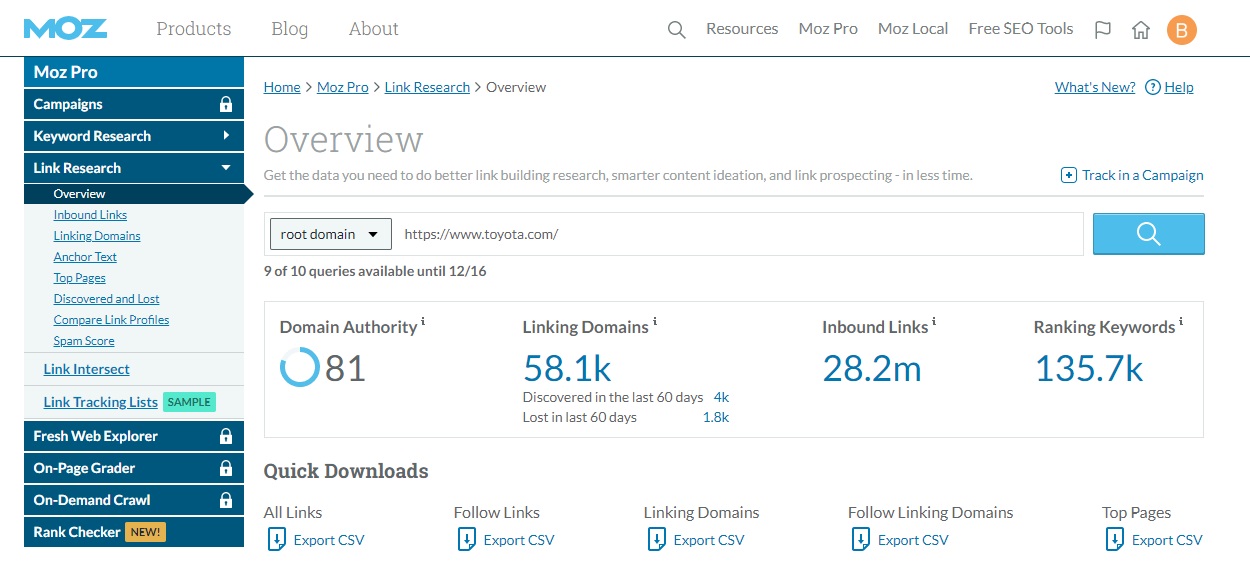
In the example above, you can see that Moz uses the term “domain authority” to assess the domain strength of Toyota.com. If you hover over the metric, it says that the metric “predicts a root domain’s ranking potential” compared to other websites in their index.
There are two reasons why overall domain strength is arguably the most crucial link building metric you can use.
First, you can use it to track the performance of your link building campaigns. You should be able to see your website’s domain strength increase as you generate more backlinks. If it doesn’t improve even as you get more links, it’s a sign you aren’t doing something right.
Second, you should be using it to link targets from other websites that have strong domain authority scores. If you only get links from low-authority sites, you are likely not going to see much, if any, increase in your domain strength. You want to get links from high-authority websites such as major news outlets, universities, and industry leaders.
Check DA for FREE 🔥
Did you know we have a free domain authority checker tool? Well we do:
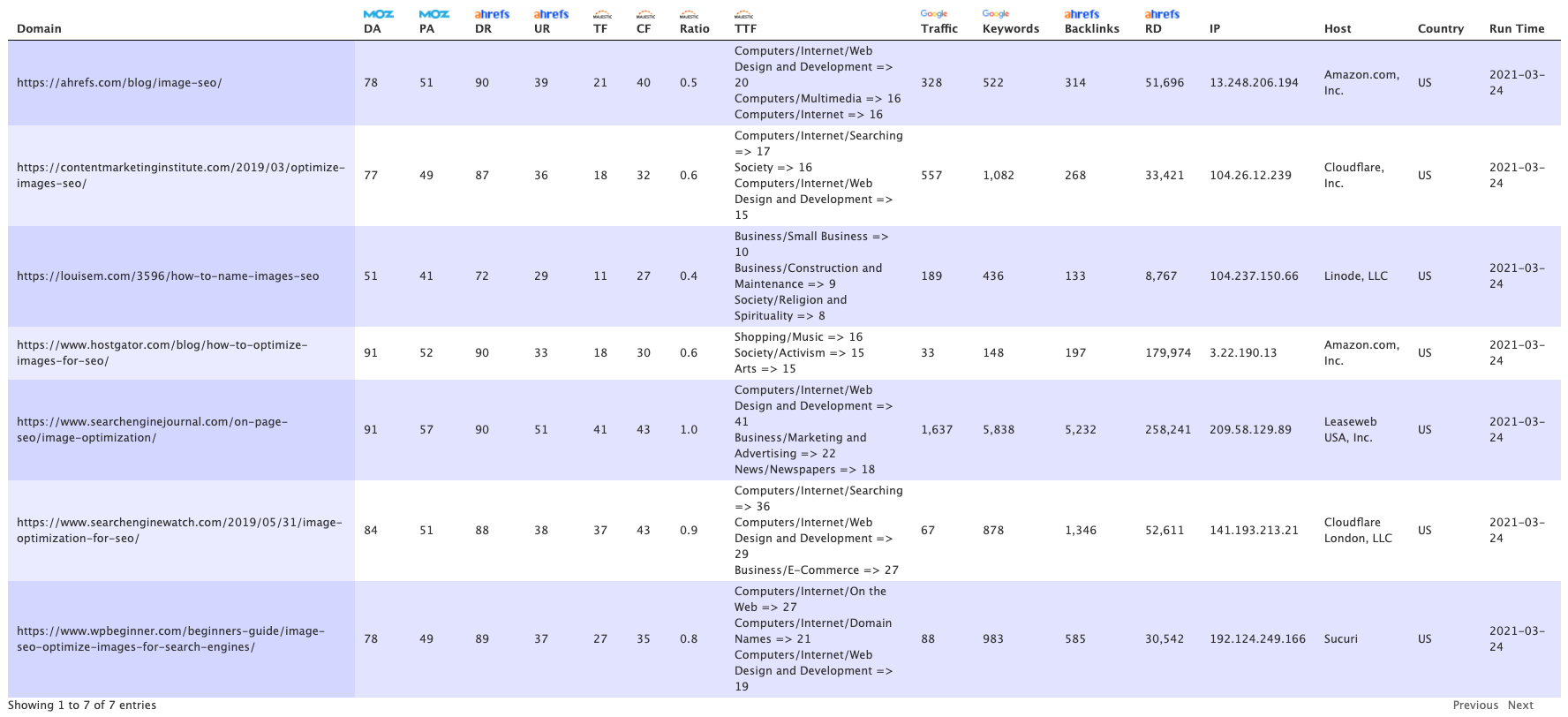
You can get 10 free domain authority lookups daily (+ other metrics like DR, CF, TF and organic traffic).
2. Page strength
Page strength works the same as domain strength, but at the level of a specific page (page-level) on your website. PageRank is the most popular metric in this group, as Google itself uses it. They rate a page on a 0 to 10 scale, where 10 is the highest possible strength score.
Typically, the PageRank or strength for all the pages on your website should peak at your home page and filter down in a slow decline. Your oldest and highest traffic pages will likely have the next highest scores, with your newest and more obscure pages having the lowest.
There are many ways to check the page strength of any website page. The Moz tool shown above includes a page authority metric, but for Google’s PageRank, you can use a free tool like prchecker.info.
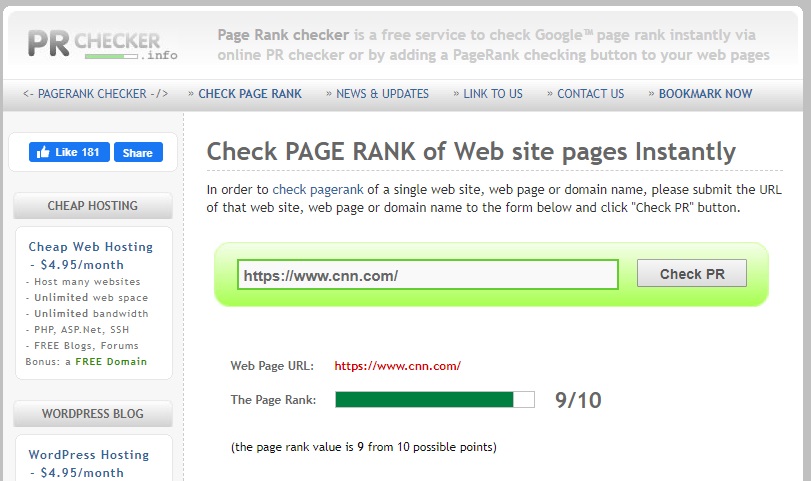
For Moz’s page authority, you can also use CNN to see how their page authority metric decreases as you move past the home page:
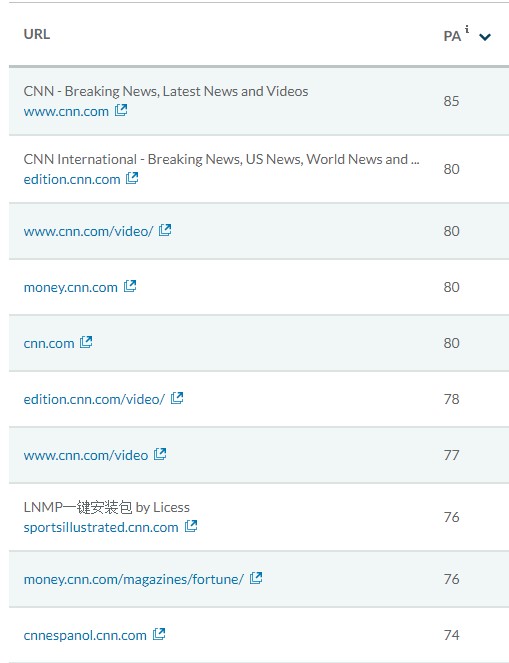
When you are planning your campaign, page strength is a useful metric to assess the quality of the website and the page link. Just like it’s better to have a link from a website with a high domain strength score, you also want a link from a page that has excellent page authority.
3. Anchor text
With this metric, we’re starting to get more into the finer strategies to make your link building campaign a success (like contextual links). Anchor text refers to the specific text that is hyperlinked with the URL back to your website.
It is essential because it helps indicate the topic of a page to search engines. It serves a similar purpose as keywords for the SEO value of your website content.
Let’s say your business is a dentist clinic. If another website links to yours, it is generally better for if the anchor text used includes your core keywords. That means keywords like “dentist” and related products or services, as well as the city where your business is located for local link building.
Here is an example of the anchor text profile for links to the Mayo Clinic website:
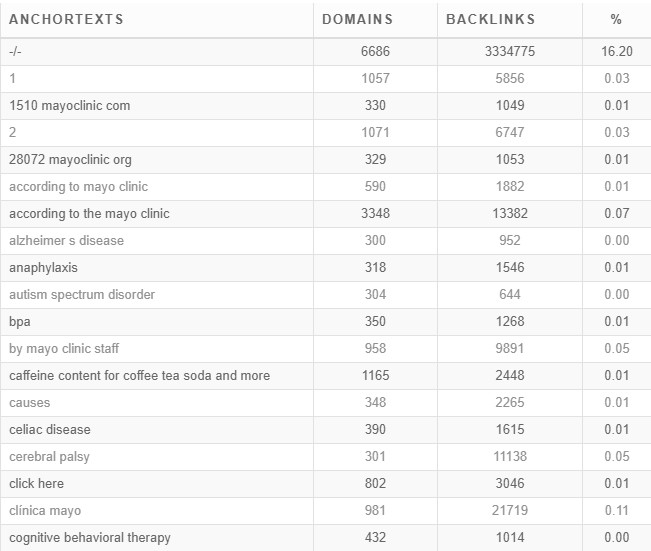
Anchor text that includes uninformative words such as “click here,” or has a number for a citation, is not as valuable. The anchor text using the Mayo Clinic name itself (or the main keywords they use in their various guides and services) are better.
The strict value of anchor text has declined over the past few years. This is mostly due to it being spammed and abused. Google has since updated its algorithm to place less importance on it and penalizing websites that abuse it.
However, that does not mean that there is no value in optimizing anchor text. It just means you need to ensure you have a diverse profile of anchor text that targets a good range of keywords relevant to your business.
4. Number of links
The number of links is a pretty self-explanatory metric to use. It refers to the total number of links to your website, which makes it easy to track and understand. While we mentioned above that the total number of links by itself is no guarantee of success, it is still a useful metric to measure.
First, it can help you tell if you are losing active links. Those are useful websites to prioritize. If they linked to you before, they are likely more open to doing so again. That helps keep your campaign from spinning its wheels.
Second, it’s an excellent way to compare your domain to competitors that rank ahead of you on SERPs. It’s good to see the bar you should set for yourself and to track them over time to see if they are gaining or losing links as well.
Third, it is good to see your total number of links increasing to know your efforts are being rewarded. On the flip side, if it stays flat, you can use that to look into where the issues are so you can make the necessary adjustments.
5. Linking root domains
Linking root domains is another important metric that measures the quantity of your link building campaign. While the number of links is essential, it’s less valuable if they’re all coming from a small handful of websites.
It’s much better to have links from a more significant number of unique domains. This metric has a much more significant positive impact on your website than just total links. For example, having 5 links come from 5 different domains is generally better than five links from only 1 domain.
The reason for this is because of how Google treats backlinks. Think of them as a positive review — when another website links to yours, it’s treated as a digital thumbs up that they like and trust your content.
So when the same domain links to your website multiple times, it’s treated like the same person just confirming their previous thumbs up. It’s not telling Google anything new in terms of how people in general trust your website.
If you want an excellent tool to check both your total number of links and root domains, you can use Majestic SEO’s site explorer tool:

6. The relevance of the linking page
Now we get into the quality side of the link building metric equation. Having lots of links and linking domains are good, but it’s better to balance that with useful quality links. We touched on that earlier when talking about domain authority, but the relevance of the linking page is also important.
In this case, a “relevant link” has to do with how similar the website linking to yours is. For example, if you run a landscaping business, then having a link from a gardening website is more relevant than from a video game blog.
There are two main reasons for targeting highly relevant links for your website. The first is that relevant links are more likely to attract real website traffic and potential customers. Let’s go back to the above example. Someone browsing a gardening website is far more likely to be interested in landscaping services than someone on the video game blog.
The second reason is for the SEO value of the link itself. Google places a lot of weight on relevancy throughout its algorithms. While they seem to be putting less importance on anchor text, as we mentioned above, they may be looking more at the relevance of the linking domain.
That’s not proven, but there is some evidence that this is where future algorithm updates are headed. So if you are going to prioritize links from two otherwise equal websites, always pick the one that is more relevant to your business.
7. Position of links on the page
Another signal of link quality and trust that Google uses is the position of the link to your website from the linking domain. The reason behind this ties into the ideas of trust and relevancy we’ve talked about above.
If you run a blog and you find another website that you want to share with your readers, where would you put the link? If it were vital to you, it would likely be somewhere front and center: the top of a web page, within the text you write to talk about it.
The idea is that link placement shows the importance and trust someone places in a link they make to another site. The less influence or trust they have, the lower on a page or more obscure placement it would probably get.
Google can tell the position of a link to your website on the linking domain. They will use it to weigh how much trust value to pass onto your domain. They are also able to track the total average position of the links to your website. If the links you have are mostly hidden, you won’t get nearly as much SEO value from them.
That’s why it is important to keep the positions of links you get in mind when you try and earn them from other websites.
8. Cost Per Link
The final link building metric you should be concerned about has to do with the ROI of your link building campaign. It’s all well and good to get lots of useful quality links, but what if the cost to do so outweighs the value they add? That’s where cost-per-link comes in.
Let’s say you’re building out a list of websites to target in your link building campaign. You start with high authority domains, add in locally and topically relevant sites, and so on. Then you begin researching each website in-depth to see how you can get a link from them.
You can try getting links to them for free to start, through broken link checks, cold emails, partnership building, and so on. Those are usually much more difficult to earn. You can then see if they accept sponsorships or paid guest posts, but you may find the cost-per-post makes it too costly for you.
You can also look into a professional link building service to generate the links for you, at a fixed cost or rate. If you want to evaluate if the service is worth it to you, you can divide the fee for their service by the links they generate for you. That cost-per-lead will be a useful way to tell if you want to keep using them or not.
Summary
With these link metrics, you’re ready to start planning your link building campaign, whether that’s kicking off email outreach or buying some links. Having a grasp of these metrics and the value of links helps your targeting process, as well as your actual link acquisition.
What’s more, understanding how to get the most from your link equity helps to make sure you maintain a good ROI and get more organic traffic.
You can also use these metrics to track the success of your campaign, or of the link building service you have outsourced to. You should see a rise in total links and root domains, as well as a corresponding increase in the domain and page strength of your website.
Hand off the toughest tasks in SEO, PPC, and content without compromising quality
Explore ServicesWritten by Adam Steele on January 2, 2020
COO and Product Director at Loganix. Recovering SEO, now focused on the understanding how Loganix can make the work-lives of SEO and agency folks more enjoyable, and profitable. Writing from beautiful Vancouver, British Columbia.





